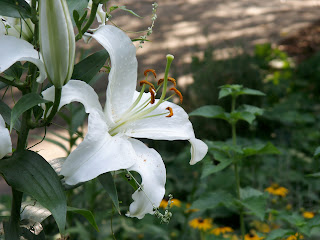I'm not sure why I'm preoccupied with blooms, especially on these dreary, fall days. Maybe it's because of the impending bleakness of winter. Rationally, I know that we need the winter's chill for gorgeous spring peonies and tulips. From a business perspective—I need the calm of winter to prepare myself for the insanely busy spring.
But right now, when I should be clearing the gardens for cool weather crops, planting garlic, and sterilizing hundreds of trays to be ready for spring transplants, I keep looking at the perennial bed, with it's overgrown black-eyed susan and lavender in need of deadheading. Just staring out the office window, willing a garden fairy to come and rip it all out. Then, instead of transplanting strawberries from the potager, I turn pages of awe-inspiring floral design books that recently arrived from Barnes & Noble.
How I love gift cards.
And while there are endless seed packs that need to be inventoried and fraise des bois seedlings that need to be started, I stalk floral websites, like Floret Flower Farm and Saipua.
I'm obsessed.
Honestly, the reason I began gardening was to ensure I'd have a continuous supply of fresh flowers, without needing to rely on some guy's guilty red roses. Historically, I've despised red roses, although Peter advocates that I let go of my aversion. (For the record, he's not the cause of my red rose animosity.)
My first gardening memories were planting annuals. Following alongside my mom, she dug holes around the lamp pole and on the side of our house. I placed a petunia in each hole, alternating red and while blooms, then backfilling dirt while she firmed each plant into place. Sometimes, we planted marigolds. And snapdragons. And my childhood favorite--pansies, with their mysterious little faces and rich hues. Up north, though, we planted those in the spring, not in the fall like I do now.
When I started gardening on my own, I swore off the basics—searching for interesting flowers with impossible to pronounce Latin names. I read, studied, enrolled in Master Gardener courses, and bought flowering plants compulsively.
Still, my flower obsession has been overshadowed in the past few years by creating kitchen gardens and an heirloom veggie plant business. The pleasure of gardening became a job, another task that consumed my time and became an obligation rather than a pleasure.
Maybe I've been thinking about flowers, because of the one-year anniversary of my mom's passing. Even in the late stages of Alzheimer's, deadheading flowers calmed her. Maybe it's because I'm desperate to regain the joy of gardening. Maybe I want it to be a source of pleasure again, not just an obligation.
And maybe, because I'm consumed with flowers, I fell in love with my most recent read, The Language of Flowers by Vanessa Diffenbaugh.
Diffenbaugh's characters are heart-wrenching. Victoria, recently emancipated from the foster care system, can only connect to the world through flowers and their meanings. I worried for her safety as she made a home in a park next to the small garden she created.
“The Victorian language of flowers was used to convey romantic expressions: honeysuckle for devotion, asters for patience, and red roses for love,” according to the book's jacket copy. When Victoria receives unwanted attention from a flower vendor, she replies with a bloom of rhododendron: “beware.” He follows with a clipping of mistletoe: “I surmount all obstacles.”
I held my breath.
And finished the book in one day.
The characters are flawed, which makes them so credible. Tattered and bruised, cynical and tired—but I rooted for them. And cried for them.
I'm an emotional wreck.
As much as I loved the story, Diffenbaugh's “Victoria's Dictionary of Flowers” is an amazing addendum. Using numerous resources, such as The Floral Offering: A Token of Affection and Esteem: Comparing the Language and Poetry of Flowers written in 1851, Language of Flowers by Kate Greenaway, and Flora's Lexicon by Catharine H. Waterman, Diffenbaugh compiled a dictionary to describe the meanings communicated by flowers and edibles, as Victoria does within the novel.
I've spent days reading the dictionary, making lists of the flowers in our gardens, deciphering their meaning.
And I started thinking about that nasty perennial bed, as well as the other plantings in front of the house. What messages greet guests when they come to our home?
Black-Eyed Susan: Justice
Daffodil: New beginnings
Forsythia: Anticipation
Iris: Message
Pansy: Think of me
Phlox: Our souls are united.
Strawberry: Perfection
(Ironic, as our pots and baskets of strawberries are looking pretty ragged right now!)

(Ironic, as our pots and baskets of strawberries are looking pretty ragged right now!)

Tulip: Declaration of love.
While the language of flowers may be a lost communication in our Skype and Tweeting world, there's a beauty in knowing the subtle, blossoming messages.
I think I might tackle the perennial bed, make it more welcoming.




























Wonderful.
ReplyDeleteYou have me missing flowers. I love fall. I think the leaves are so beautiful. But I too miss the beauty of flowers this time of year.
ReplyDeleteVery nice Julie.....Shows you still have lots of wonderful memories in the past, but the one's to come.....Wow! :)
ReplyDelete